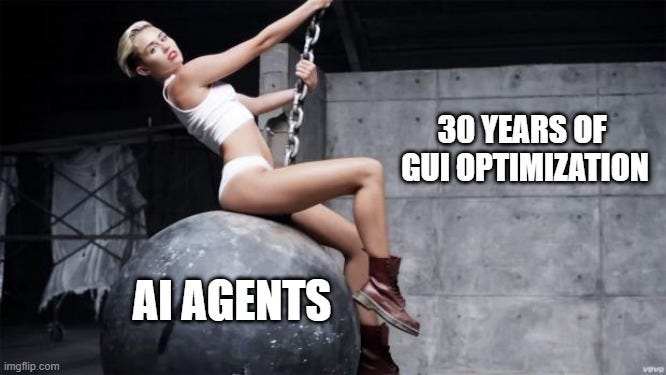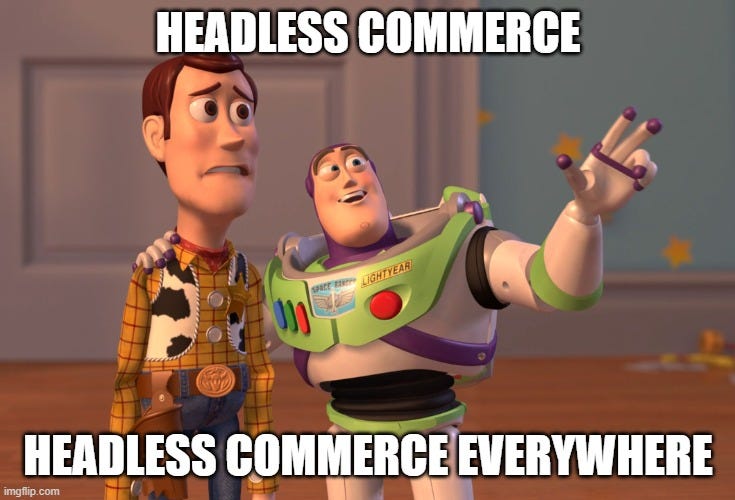The Great GUI Overhaul
Who will survive the GUI revolution and who is under trouble
Only two years after the public release of ChatGPT 3.5, OpenAI has captured over 8% of the U.S. market as a primary search tool1 .
The once-unbeatable giant Google is facing a serious existential threat. This trend aligns with what we call as "The Great UI Overhaul”, which predicts that most existing interfaces will transition to agentic interfaces over the next decade, unlike interfaces for humans today. This shift will fundamentally impact every consumer internet product (and probably Enterprise as well, but we’ll focus on the consumer piece in this post).
This post explores the transformation and its impact, focusing on what matters most to us: commerce.
The first GUI
The first GUI for consumer internet use was Mosaic, the first browser, which was released in 1993 (and was the inspiration to Netscape which was released in 1994). It introduced features like inline images, bookmarks and navigation buttons, laying the foundation for modern web browsers.
Mosaic was pivotal in transforming the World Wide Web from a text-based tool for researchers into a visually rich medium for everyday consumers. For the first time, internet was intuitive.
We've come a long way since Mosaic. Thirty years later, a significant portion of the world’s commerce now operates through the browser, which became the gateway to the internet, which became the highway of human collaboration. So not trying to be over dramatic here, but the browser can be seen as the driving wheel to human collaboration. Every major business had to adapt to the internet (and to its human manifestation, the browser), creating a digital, browser-based version of itself. We call these web pages, websites, or webapps.
Alongside it, starting in the early 2000s, APIs began to emerge and evolve (with REST introduced in 2000), enabling third-party developers to build on platforms like Salesforce. But while APIs were always designed for developers, GUIs within the browser were built for everyday users. The distinction was always there - browsers for human users and APIs for developers.
Amazon, “The Everything Store”. One of the most widely used internet interfaces in the world
This arrangement of humans interacting with browser-based GUIs, had significant second- and third-order effects. The GUI-driven commercial experience was optimized to maximize $ value per user. Upsells, personalized recommendations, retargeting ads, algorithms analyzing user behavior to suggest tailored products and services (e.g., "Customers also bought"), A/B testing, frictionless checkouts, SEO-optimized content, dynamic pricing, real-time adjustments, cart analysis tools, and even tracking mouse movements—endless resources were poured into refining this system (this is not actually not a full exhaustive list, you can probably fill books with the theory behind this).
It's hard to fully appreciate how many billions of dollars in human hours, companies founded and acquired, and engineering, design, and executive effort went into building this structure. But it’s all going to be wiped out in the next few years.
30 years to build it. One AI to wipe it out
Within 3 months ChatGPT was launched, it went from 0 to 100 million active users. Two years later, it has chipped away ~8% of Google’s search market in the U.S. It was very clear, very early on, that users love chat or voice interfaces, which feels more intuitive to users.
ChatGPT started from pure LLM (tokens-in/ tokens-out), and gradually advanced into more agentic experiences over time by adding memory and external tool calling. The current ChatGPT experience is already agentic, as it not only runs a pure transformer “naked” model, but can recognize the user intent and call tools, like generating images on the fly or conducting internet search. It is worth noting that only recently (Dec-24) OpenAI added the real-time search capability, yet the market share they’ve captured is entirely based on non-real-time search. With the recent MCP protocol launched by Claude (tl;dr - it a standardized way for LLMs to authenticate and interact with external services), it is very clear we are heading into more tool calling and agentic experience of the traditional chatGPT interface. Agents are the natural progression of LLMs, and with many competing frameworks like LangChain emerging, the race for agentic AI began.
At the current pace of chat interfaces overtaking Google’s search dominance, it’s clear that over time, search will be entirely dominated by AI-based chat interfaces.
If chat can replace classical search as an interface, why stop there? Why not replace every interface? When agents can fetch what they need from the internet, call APIs, use tools, and eventually even build tools for themselves, why should we rely on anything else? The next logical step is applications like e-commerce- shopping agents- and eventually replacing every browser or mobile experience we have with the internet. Agentic interfaces are far better intermediaries for our intents than classical search or everyday browsing. It’s easy to see how these interfaces will transform every type of internet usage.
This brings us to an unimaginable yet obvious conclusion: all GUIs are destined to be replaced by agentic interfaces.
We’ll want to discuss on one specific impact of this trend: commerce.
The first-order effect is straightforward: users will shop through agents, bypassing traditional GUIs like Shopify or Amazon storefronts. But what does this mean for those businesses?
E-commerce can be thought of as having two layers:
The customer-facing layer: This includes GUIs, branding, and checkout experiences - the aspects users interact with directly.
The backend layer: This manages physical storage (e.g., Amazon warehouses), merchant listings and inventories, financial integrations, and logistics. Everything that has to do with managing the backend of the business.
When the traditional GUI becomes obsolete, replaced by shopping agents, these agents will primarily interact with the backend layer through APIs. The critical shift here is that agents behave fundamentally differently than humans:
Agents don’t care about visuals. They’re indifferent to colors, design, or clickbait tactics.
Agents process at scale. They can sift through thousands of options in milliseconds without fatigue. What is impossible for a human eye and brain, such as going through tens of different commerce sites just to get the full price, or benefits, is actually an easy task to a machine.
Agents prioritize efficiency. They value the cheapest price, fastest shipping, and highest reliability. Brand loyalty is irrelevant; they’re loyal only to efficiency. There will probably be massive playbooks written about new types of agentic SEO, aimed to the machine vs. the human.
This renders many GUI-driven optimizations of the past 30 years useless. Agents don’t need CSS or JavaScript—they just need a clean, structured JSON list of options. So websites can be stripped away to their core logic.
A good example of this shift is the llms.txt standard, which allows LLMs to process websites efficiently by stripping them down to their most compact, digestible form. It’s a glimpse into how agents interact with the web: lean, efficient, and without fluff.
Anthropic website in llms.txt format
What this means for e-commerce
In short, to survive, e-commerce stores can either:
Open their backend to agents.
Develop their own consumer-facing agents.
Do both.
Let’s break this down. Opening the backend to agents effectively makes your store headless - agents can access your catalog, view products and prices, and place orders as external parties. This isn’t how the world operates today, with a few exceptions, like TikTok's headless stores through its Shopify partnership.
In general, agents lack a standard way to connect to merchants, authenticate, and interact commercially. This gap creates an opportunity to define new protocols and infrastructure for agent-commerce authentication and interactions, enabling a seamless connection between agents and merchant backends.
Another approach is developing consumer-facing agents. This will undoubtedly be a strategy for platforms like Shopify (their Shop app already hints at an agentic interface). It’s almost certain that every major platform, like Amazon, will develop its own agent. There’s also potential for a new wave of agent-as-a-service platforms—think of agents as the new apps. Building them will become easier over time, lowering the barrier for adoption.
In the long run, traditional online stores as we know them today will likely disappear. They will either evolve into agent-driven interfaces or transition to backend-only operations, catering directly to agents.
The dominant path will depend on market dynamics. If external agents evolve faster than e-commerce businesses can adapt, stores will have no choice but to expose their backend to those agents in an expanding rate. While these businesses will resist, the GUI optimizations they’ve relied on for decades may become liabilities in this new paradigm.
We also expect a rise in headless e-commerce stores: shops that exist entirely as backends optimized for agents. These stores will compete on agent-driven criteria like price, quality, and reliability - without the overhead of branding or GUIs. Traditional internet brands will likely face a reckoning, forced to transition into the agentic economy or fade away.
Summary
The future of e-commerce is headless. This presents a challenge for established players who’ve spent decades perfecting GUIs for human users. Transitioning to backend-focused businesses will be painful but necessary.
At the same time, this shift creates opportunities for startups:
Build agents with great UX and discovery mechanisms.
Outpace traditional e-commerce players in adopting agentic interfaces.
Build fully backend stores optimized for agents.
Optimize commerce SEO based on agentic criteria.
And many more...
Startups that can innovate faster than incumbents can adapt will capture a significant share of the e-commerce market, which has historically been highly concentrated.
Finally, this evolution will require a rethinking of financial interfaces. Agents will need connectors to complete transactions autonomously. As outlined in a previous post, this transformation also introduces new challenges in cybersecurity and fraud prevention. The agentic economy is coming, and it will reshape internet commerce as we know it.
At OpenCommerce, we’re building the infrastructure for autonomous payments. If you have insights or want to collaborate, email us at:
ayal@opencommerce.xyz
idan@opencommerce.xyz
Source: https://www.barrons.com/articles/google-stock-alphabet-chatgpt-ai-search-722a2758?utm_source=chatgpt.com)







